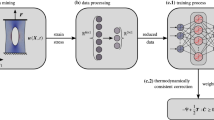Abstract
Experimental identification of anisotropic behavior law is currently obtained by performing several complicated tests and a long duration of experiments. This paper describes a new technique allowing for the identification of HILL anisotropic parameters by inverse technique method based on deep drawing of a cylindrical cup. The identification approach is based on the artificial neural network (ANN) computation trained from finite element simulation. The results obtained by ANN models and by the finite element method shows a good agreement.
Similar content being viewed by others
References
Hambli R (2002) Prediction of burr height formation in blanking processes using neural network. Int J Mech Sci 44:2089–2102. doi:10.1016/S0020-7403(02)00168-6
Chung-Feng Jeffrey Kuo Yi-Shiuan Wu (2005) Application of a Taguchi-based neural network prediction design of the film coating process for polymer blends. Int J Adv Manuf Technol 27:455–461. doi:10.1007/s00170-004-2215-3
Waszczyszyn Z, Ziemianski L (2001) Neural networks in mechanics of structures and materials—new results and prospects of applications. computers and structures 79:2261–2276
Huber N, Nix DW, Gao H (2002) Identification of elastic plastic material parameters from pyramidal indentation of thin films. Proc R Soc Lond A 458:1593–1620
Pernot S, Lamarque C-H (1999) Application of neural networks to the modelling of some constitutive laws. Neural Netw 12:371–392. doi:10.1016/S0893-6080(98)00115-4
Tomonaru F, Genki Y (1998) Implicit constitutive modelling for viscoplasticity using neural networks. Int J Numer Methods Eng 43:195–219
Furukawa T, Hoffman M (2004) Accurate cyclic plastic analysis using a neural network material model. Eng Anal Bound Elem 28:195–204. doi:10.1016/S0955-7997(03)00050-X
Turk R, Perus I, Tercelj M (2004) New starting points for the prediction of tool wear in hot forging. Int J Mach Tools Manuf 44:1319–1331. doi:10.1016/j.ijmachtools.2004.04.020
Muliana A, Steward R, Haj-Ali Rami M, Saxena A (2002) Artificial neural network an finite element modeling of nanoindentation tests. Metallurgical Mater Trans 33A:1939–1947. doi:10.1007/s11661-002-0027-3
Abendroth M, Kuna M (2003) Determination of deformation and failure properties of ductile materials by means of the small punch test and neural networks. Comput Mater Sci 28:633–644. doi:10.1016/j.commatsci.2003.08.031
Pasquinelli G (1995) Simulation of metal-forming-processes by the finite element method. Int J Plast 11:623–651. doi:10.1016/S0749-6419(94)00034-4
Lamine Boubaker M, Boisse P (1998) Comportement élastoplastique anisotrope pour l’analyse numérique des coques minces en grandes transformations. Revue européenne des éléments finis 7:09–73
Khalfallah A, Bel Hadj Salah H, Dogui A (2002) Anisotropic parameter identification using inhomogeneous tensile test. Euroean Journal of Mechanics A/solids 21(6):927–942
Hill R (1948) A theory of yielding and plastic flow of anisotropic metals. Proc R Soc Lond A Math Phys Sci 193:281–297. doi:10.1098/rspa.1948.0045
Davalo E, Naim P (1993) Des Réseaux de Neurones. EYROLLES, Paris
Author information
Authors and Affiliations
Corresponding author
Rights and permissions
About this article
Cite this article
Chamekh, A., Bel Hadj Salah, H. & Hambli, R. Inverse technique identification of material parameters using finite element and neural network computation. Int J Adv Manuf Technol 44, 173–179 (2009). https://doi.org/10.1007/s00170-008-1809-6
Received:
Accepted:
Published:
Issue Date:
DOI: https://doi.org/10.1007/s00170-008-1809-6




